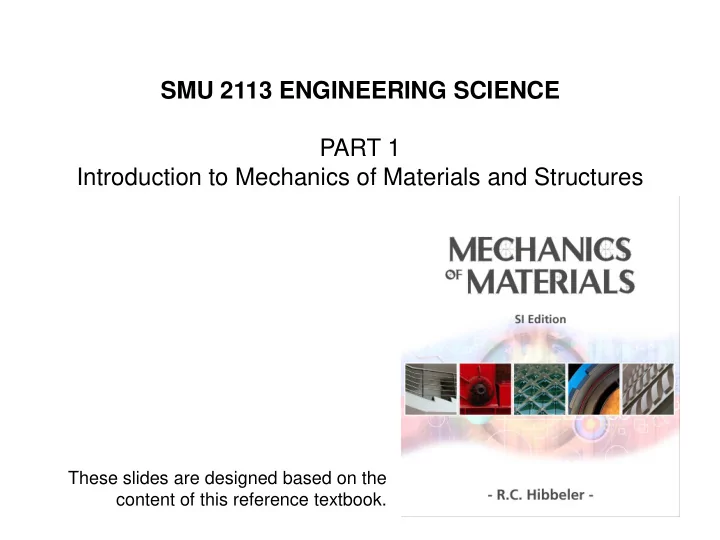

SMU 2113 ENGINEERING SCIENCE PART 1 Introduction to Mechanics of Materials and Structures These slides are designed based on the content of this reference textbook.
OBJECTIVES To introduce basic principles of the mechanics of materials and structures. To illustrate the applications of mechanics of materials for structural members subjected to simple loading conditions. At the end of PART 1, students should be able to: - calculate deformation, strains and stresses of a structural member subjected to simple loading, namely axial, direct shear, torsion and bending. - identify the various mechanical properties of common engineering materials. - analyze elastic deflection of a beam.
Mechanics of Materials A branch of mechanics that studies the relationships between external loads applied to a deformable body and the intensity of internal forces acting within the body.
SCOPE Stress Strain Equilibrium of forces Mechanical properties of materials Stress and strain curve Axial force Torsion Bending Numerous examples/ applications
Typical Engineering Structures Applications involving combined loading
Equilibrium of a deformable body A particle or body is in equilibrium provided it is at rest if originally at rest or has a constant velocity if originally in motion. Types of external loads
Equilibrium of a deformable body Equations for equilibrium of forces and moments are employed to determine support reactions M 0 ; A 18 . 75 kN B y F 0 ; B 33 . 75 kN y y
Concept of stress General loading conditions Strained Element
Concept of stress Normal stress The intensity of force acting normal to A F z lim z A A 0 Shear stress The intensity of force acting tangent to A F x lim zx A A 0 F y lim zy A A 0
Direct normal stress Average normal stress P z A
Applications Examples of structures under direct tensile stress Cable Tie rod
Applications Examples of structures under direct compressive stress
Average shear stress Shear stress is the stress component that acts in the plane of the sectioned area. V is the internal resultant shear force at the section (V = P/2) Average shear stress V avg A
Applications Single-shear connection Lap joint
Applications Double-shear connection Lap joint
Concept of strain Strain is used to describe the deformation of a body by changes in length of line segments and the changes in the angles between them After straining
Normal strain Normal strain is the elongation or contraction of a line segment per unit of length Average normal strain s s avg s s s 1
Normal strain
Shear strain Shear strain is the change in angle that occurs between two line segments that were originally perpendicular to one another Shear strain at point A lim nt 2 B A along n C A along t
Shear strain
Recommend
More recommend